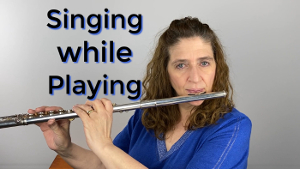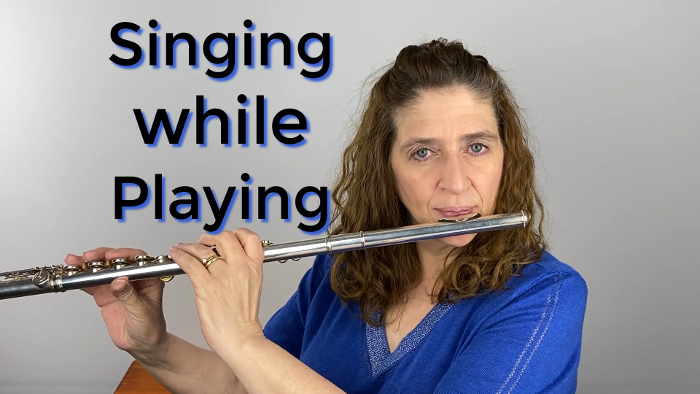Have you ever tried playing and singing at the same time? It is an extended flute technique that actually improves your tone when you learn to do it! Singing while playing is not just a 21st century extended flute technique. It’s an exercise that you can use to warm-up, that also builds resonance in your tone!
Singing and playing is not a very difficult thing to do it just isn’t the most natural thing to do. We can all sing (yes all!) but sometimes thinking about doing that while you play seems difficult. But it isn’t difficult. You can do it!
When you begin to work on this technique you should pick a piece of music or exercise that you will use when you warm-up. You can also use Robert Dick’s Tone Development Through Interpretation. This book is where the singing and playing technique for tone came to fruition. Robert Dick’s book is fantastic and full of new ways to develop your tone with singing and playing as only one aspect.
However, if you don’t have this book, you can choose another exercise that will work for singing and playing. Pick exercises that don’t skip all over the place. For example, Ex 1 in Taffanel and Gaubert’s 17 Grand Exercise for the Flute. Also,if you can’t sing it easily without the flute, then you won’t be able to do it with the flute.
To learn how to sing and play begin by singing. Take a note located in an easy part of your singing voice and sing it gently. Then while you are singing it make an embouchure. What you are doing is showing that you can sing with a flute embouchure. Now add blowing air through your embouchure while you sing. This is going to be exactly how you will do it on the flute. If you can accomplish this then you can definitely do it on the flute.
Don’t be discouraged when you try this that you might blow more air then when normally playing flute. This exercise will help you to figure out how it is done on the flute. And once you do it without the flute, you’re ready to do it on the flute.
Begin by playing an F on the flute. Now take the flute away and sing the F. Put the flute back on your lip and sing. If you can’t get the sound out, it might be because you need more air pressure behind the sound. Another trick to get yourself to ease up and sing is to make an embouchure away from the flute and sing an F. Then while you are singing you bring the flute up to your lip and just continue singing while the note sounds. A few time trying this and you will have it down.
How Does it Help Your Tone?
Now let’s talk about why you would want to do this. There are 20th and 21st century pieces that call for this technique in the music. Singing while playing does create a very interesting effect, and adds a great nuance to a piece when that is put in by the composer. But apart from that, what does it do for you? Why would you sing and play? And what does that have to do with tone?
Part of achieving a fantastic tone is opening the throat. I would say that nearly no one who comes to me for lessons, naturally has an open throat. These students might not have a totally closed throat but it isn’t totally open either. When a person sings their throat naturally opens up. It is part of the singing experience. Basically, the back of your tongue goes down, and your soft palate goes up. This creates a straight pipe that goes from you voice box all the way up into your sinuses. When you sing and play, it helps to achieve that same feeling. You can really feel the throat being open, and it helps to understand what to do when you are playing and not singing.
Try singing and playing again. Analyze what is happening. Think about that straight pipe extending from the voice box all the way to the sinuses. Ask yourself if your are keeping the throat and embouchure tension free. When you are demonstrating this remember that it doesn’t have to be played fast or slow. Whatever tempo allows you to do it comfortably is great.
When you are playing the exercise with the singing, don’t worry about which octave you are singing in. You want to sing in the octave that best suits your voice. When the playing gets too high, then have your voice jump down the octave. Don’t ever strain to sing in and octave that is uncomfortable for you.
Now when you feel comfortable singing and playing an exercise, then begin again and somewhere in the exercise stop the singing and only play. Ask yourself if you kept the throat exactly the same. Did it close once you stopped singing? You can begin singing and playing again and stopping occasionally. Once you begin to understand and feel what it is like to play with an open throat, then you can see if you can play an exercise without singing but always analyzing what is happening with your throat.
So add singing and playing to your repertoire of warm-ups. The resonance that comes from it will be something you will want to foster. It adds this resonance because once you start engaging the sinuses, a resonance comes that you can’t get any other way. You need to have that resonance for your sound to carry, for your pianos to be heard in a hall.
It’s a fantastic way to practice. It’s a great exercise and it gives you a little variety in your practice routine.
Try singing and playing for a more resonant tone. You’ll be so glad you did.
Have Fun!
DoctorFlute
Watch me demonstrate this: FluteTips 101 Singing While Playing for Better Resonance in Your Tone

Singing and Playing to Create a Better More Resonant Tone – FluteTips 130

FluteTips 11 Support – Ribcage Air

FluteTips 26 Open Sinuses for a Better Tone


